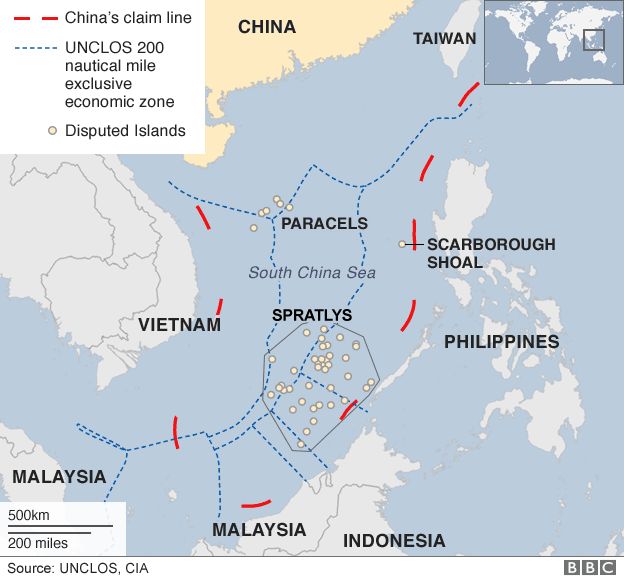
Malaysian censors have ordered a scene to be cut from DreamWorks film Abominable before it is screened there - because of a brief glimpse of a map.
It is the third South East Asian country to take offence at the scene in the film, a Chinese co-production.
The contentious map shows the "nine-dash line", which China uses to show its claims in the South China Sea.
Parts of the sea and various island groups are claimed by five other Asian countries, as well as China.
Vietnam has already pulled the movie - while Philippine politicians are calling for a DreamWorks boycott.
It might be merely a backdrop in an animated movie - but it shines a spotlight on one of the world's hottest territorial disputes.
Abominable is an animated children's movie which actually has nothing to do with the South China Sea.
It's about a Chinese girl from Shanghai who discovers a yeti on her roof, strikes up a friendship with him, and - against all odds - manages to take him back to Mount Everest.
The girl, Yi, has a makeshift shed on the roof of the high-rise where she lives. In that shed, there's a big map of East Asia on the wall, with pictures and notes pinned to it.
And it shows the South China Sea - with a series of lines marking what's known as China's nine-dash line.
The South China Sea is a strategically important region, rich in potential natural resources and fishing grounds, and lying between several influential countries.
China says it has always controlled a large chunk of this territory. The nine-dash line carves out by far the largest portion - leaving only a small coastal strip to each of the other claimants.
In 1947, China issued a map detailing its claims, and insists history backs up its claims.

The other claimants beg to differ.
Vietnam also has historic maps showing its claims, while the Philippines invokes its proximity to some of the islands, which have long been populated by Filipinos.
While Taiwan's claim mirrors that of China (and China considers Taiwan to be part of China anyway), Malaysia and Brunei insist parts of the sea fall within their economic exclusion zones as defined by United Nations laws.
The Philippines have sought international arbitration - and a UN tribunal in 2016 backed Manila, saying China had violated the Philippines' sovereign rights.
Beijing, though, boycotted the proceedings and the ruling hasn't had any consequences.
China's rapidly growing influence in the region has the other claimants torn between taking a stance - or bowing to Beijing's economic might.
It's hard to say, as it doesn't actually play a role in the movie.
But Abominable is the first co-production between US company DreamWorks and China's Pearl Studio production firm.
Within China, the sea is routinely shown with the nine-dash line. So for the Chinese side of the co-production, it's simply an accurate and normal map.
Movie-goers in Vietnam, though, were quick to accuse China of inserting the map to gradually make its claims less and less controversial on the global stage.
In fact, Beijing doesn't merely claim the territory: it runs naval patrols in the area and, for years, has been building military outposts on the disputed islands.
In some cases, small rocky reefs have turned into fully fledged military runways.
Over the past few years, China has become more insistent on territorial questions.
It has, for instance, been increasingly strict in policing how foreign firms describe Hong Kong - which is part of China but has a special status - or Taiwan, which is self-ruled but which Beijing sees as a province of the mainland that has broken away.
This has led to officials and outraged Chinese social media users going after Western companies that use "wrong" maps.
Just this week, Christian Dior apologised to China for using a map of China without Taiwan.
"The film has been given approval for screening in Malaysia," the Malaysian film board chairman Mohamad Zamberi Abdul Aziz told news agency Reuters.
"Under the condition that the controversial map is removed from the film."
Vietnamese movie-goers were the first to notice the nine-dash line - and officials swiftly ordered the film to be pulled.
Next was the Philippines, where public and politicians were equally upset. Foreign Minister Teddy Locsin on Twitter called for a boycott and speculated about cutting the map out of the movie.
The movie has been showing in the US since last month, and the map scene has largely gone unnoticed.
Yet the US is also frequently at loggerheads with Beijing over the South China Sea.
The US Navy routinely carries out what it calls "freedom of navigation" acts. Its ships sail through what the US calls international waters - only for China to accuse it of provocation and interference in regional matters.